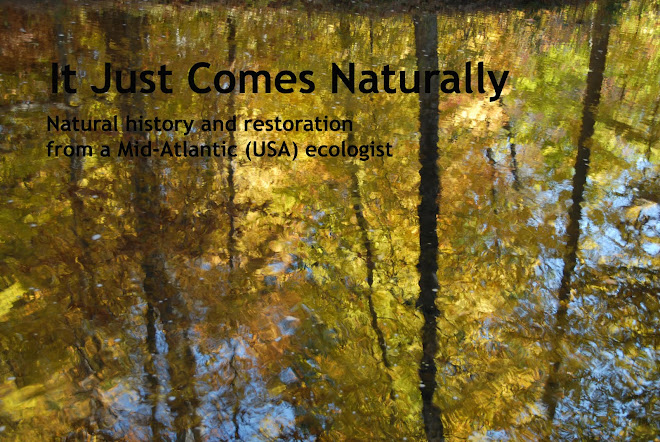The Bronx River in Bronx River Park.
The rock vein on the right side of the image is an in-stream habitat improvement structure.
On Saturday, March 24, I took a tour of three restoration sites along the Bronx River in New York as part of the Society for Ecological Restoration's Mid-Atlantic/New England chapter conference held the previous day at Brooklyn College.
The Bronx River (a creek, really) rises in Westchester County north of New York City and flows 23 miles to its mouth at the East River. The lower half of the watershed lies in the Bronx, where the stream is tightly confined to a narrow riparian corridor hemmed in by the Bronx River Parkway and the commuter railroad line serving the northern suburbs. The watershed is fully urbanized/suburbanized, so the stream is "flashy" (i.e., it floods readily and rapidly during most rain events because of the extensive impervious cover throughout the watershed).
Our first sop was in one of the New York City parks, Bronx River Park, just north of the New York Botanic Garden and the Bronx Zoo. There, members of the non-profit Bronx River Alliance and New York City Parks' Natural Resources Group showed our group a perennial wet cricket pitch that had been converted to a flood detention basin densely planted with willows and other native trees. Then, our group walked a bit downstream to view areas where Japanese knotweed (Fallopia japonica) had been uprooted and replaced with saplings of native trees.
With traffic on the Bronx River Parkway roaring in the background,
a new riparian forest is growing on the floodplain (covered with invasive lesser celandine (Ranunculus ficaria).
After restorationists hand-dig out Japanese knotweed,
they lay down a layer of fabric and plant new tree saplings in holes in the cloth.
Our second site was further downstream, outside the park. Behind a huge home furnishing and carpet store called ABC, we visited a restoration and art installation called WaterwashABC. Environmental artist Lillian Ball has created environmental art installations called "Waterwash" in various locations, all of which serve to clean stormwater runoff in an aesthetically appealing way. At WaterwashABC, Ball replaced an unsightly, rubble-filled, invasive-dominated slope leading down to the Bronx River behind the ABC store with an attractively landscaped water-permeable pathway leading down to a long, narrow stormwater wetland that receives all of the runoff from the store's parking lot. The wetland vegetation will remove sediment, nutrients, and pollutants before the water enters the Bronx River.
The porous pavement walkway, surfaced with recycled crushed glass,
leads down to the stormwater wetland observation deck behind the ABC store.
The stormwater wetland was installed last summer. Across the Bronx River,
the city has converted an old cement factory to Cement Factory Park.
Our third stop was a salt marsh restoration site at the mouth of the Bronx River in the city's Soundview Park. Nearly all of the tidal wetlands in New York have been filled to create developable upland, and the city is trying to recover some of the lost habitat to improve water quality. At Soundview Park, the U.S. Army Corps of Engineers excavated countless yards of fill to create new tidal wetlands. Most of the fill was used to build-up a derelict area of the park that had become overgrown with invasive plants. The filled area will be restored to upland forest.
New York City Parks personnel discussing the wetland restoration project. All of the area to the left of the group, out to the orange fence line in the water in the background, has been excavated to re-create wetland.
The upland area where the excavated fill was spoiled. The fill was covered with a combination of compost and good, clean soil.
The recreation path temporarily closed wile the wetland restoration work is underway. The brown hill on the left is the compost that is mixed with clean soil and used to cover the excavated ill. The boulders were all removed from the wetland restoration site and will be moved off site.





























